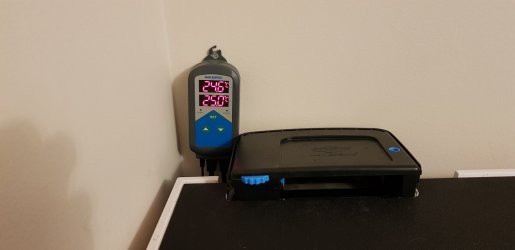This has come up a few times recently and if you are in the Northern hemisphere it is a good time to be thinking about it. Some time ago I realised that however much we try to save on equipment and hardware it really is not long before what is inside the tank is worth more than the tank itself (even if only to ourselves) so it is worth protecting.
I have had a couple of heater did not come on failures in the last 20 or so years. None of these were serious as I always managed to get a replacement before the temp got too low to cause any loss. I once had a thermostat fails to turn off and was a little less lucky.
Now each of my tanks has a temperature controller independent of the heater itself. The ones I have are these. This particular version has 2 heating sockets and allows you to set separate day and night temps (I don't use that feature). It also allows you to set the on and off temperature independently. Mine are set to go off when the temp reaches 25C and to turn back on when it reaches 24.5. The controller has its own probe and simply shuts off the power to the sockets once the target temp is reached. Once it drops below the minimum temp it turns the power on again. So in theory I could just use cheap heaters without a thermostat.
Instead I have decent heaters that are set to turn themselves off at 25.5C. I chose the slightly higher temp so that the heaters are not constantly going on and off because the calibrations are slightly different. This gives me a backup if the controller fails to shut off the power. The heaters should still shut off at 25.5 and I will know what has happened if the tank temp rises above 25. If one of the heaters fails that's ok because the other one can still do the job. This is easy to check for because both heaters should always be on or off at the same time. (I don't understand why some people have 2 heaters set to different temps???). If the controller fails to turn the heaters on I will see from the temp - or no display if it has failed completely. In this case I would just bypass the controller.
Here is the controller on my community tank. In this case I know the heaters are off, so the tank has reached 25 and is now dropping back towards 24.5 when the heaters will come back on. (The little LEDs are on when heating is on).

More importantly I can see what is going on from anywhere in the room. I do have a cheap digital thermometer in each tank (these are surprisingly accurate) so I can double check that the readings make sense.
Obviously I cannot guarantee against failure from every possible scenario but it feels a lot better than relying on a single piece of equipment - especially as I am regularly away from home for several days at a time.
I have had a couple of heater did not come on failures in the last 20 or so years. None of these were serious as I always managed to get a replacement before the temp got too low to cause any loss. I once had a thermostat fails to turn off and was a little less lucky.
Now each of my tanks has a temperature controller independent of the heater itself. The ones I have are these. This particular version has 2 heating sockets and allows you to set separate day and night temps (I don't use that feature). It also allows you to set the on and off temperature independently. Mine are set to go off when the temp reaches 25C and to turn back on when it reaches 24.5. The controller has its own probe and simply shuts off the power to the sockets once the target temp is reached. Once it drops below the minimum temp it turns the power on again. So in theory I could just use cheap heaters without a thermostat.
Instead I have decent heaters that are set to turn themselves off at 25.5C. I chose the slightly higher temp so that the heaters are not constantly going on and off because the calibrations are slightly different. This gives me a backup if the controller fails to shut off the power. The heaters should still shut off at 25.5 and I will know what has happened if the tank temp rises above 25. If one of the heaters fails that's ok because the other one can still do the job. This is easy to check for because both heaters should always be on or off at the same time. (I don't understand why some people have 2 heaters set to different temps???). If the controller fails to turn the heaters on I will see from the temp - or no display if it has failed completely. In this case I would just bypass the controller.
Here is the controller on my community tank. In this case I know the heaters are off, so the tank has reached 25 and is now dropping back towards 24.5 when the heaters will come back on. (The little LEDs are on when heating is on).

More importantly I can see what is going on from anywhere in the room. I do have a cheap digital thermometer in each tank (these are surprisingly accurate) so I can double check that the readings make sense.
Obviously I cannot guarantee against failure from every possible scenario but it feels a lot better than relying on a single piece of equipment - especially as I am regularly away from home for several days at a time.
Last edited:



